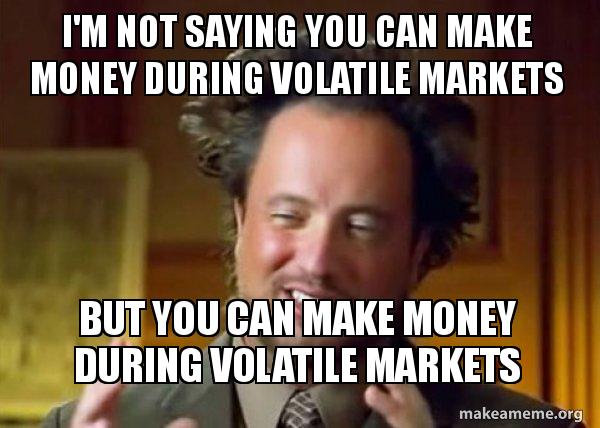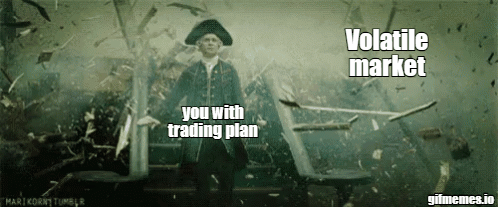
Overview: Volatile markets can feel scary, but they don’t have to ruin your trading. The key is to stay calm, follow a clear trading plan, and avoid emotional decisions. Fast moves and panic-selling usually lead to mistakes. Instead, protect your edge by managing risk, using exit signals, and trusting your system.
Don’t try to control the market, just focus on what you can control: your actions, your plan, and your mindset. With the right system, even tough markets can become learning opportunities that make you a stronger trader.
When markets start swinging wildly, fear and confusion tend to take over. Prices drop, bounce back, then fall again. News headlines go from panic to optimism in a matter of hours. In the middle of this chaos, it’s easy to feel lost, or worse, make decisions that damage your portfolio.
Trading in volatile markets can test even experienced investors. But if you’ve built the right foundation, it doesn’t have to shake your confidence. The key isn’t predicting every move. It’s sticking to what you can control: your edge, your discipline, and your process.
How can you keep your trading game strong, even when the market feels anything but stable?
1. Stick to a Verified Trading Plan
In times of high volatility, you don’t rise to the occasion; you fall back on your preparation. That’s why a trading plan in bear market conditions is important.
A trading plan gives you the foundation when everything else feels uncertain. It outlines when to enter, how much to risk, and when to get out. Without it, emotions take over, and panic sets in. Plans should be written down, back-tested, and based on a strategy that’s worked through past market cycles.
Think of it like driving through a storm. You need working headlights, clear lanes, and a route you trust. Your plan is what keeps you from accidents.

2. Follow Your Exit Signals Without Question
Volatility affects your emotions. That’s when traders start second-guessing themselves:
“Maybe this bounce means I should hold a bit longer.”
“What if I sell now and it goes back up tomorrow?”
But when you do that, you’re no longer following a system. You’re guessing.
A solid exit strategy for traders overrides that uncertainty. You’re reacting to what’s happening, based on a rule you already trust.
The SPA3 Investor system is built on that principle. It delivers objective exit signals, based on technical criteria, not gut feelings. It doesn’t ask you to “feel” the market. It just tells you what the data says, so you can act decisively.
If you ignored exits during the last downturn, you probably felt it hard. It’s a reminder: when your plan says exit, exit. Without hesitation. That’s how you protect your capital.
3. Avoid Subjectivity and Emotional Trading
When markets drop fast, we naturally want to take control. But often, the best move is to follow the plan, not your feelings. Emotional trades come from fear, hope, revenge, or even boredom. They rarely end well.
This is especially dangerous in high-volatility periods when every candle on the chart feels like a threat or an opportunity. But if your edge is real, it doesn’t need your emotions. It just needs your discipline.
Letting go of control might feel counterintuitive. But in trading, you’re not meant to control outcomes. You’re meant to control your actions.

4. Manage Risk Before the Storm Hits
Too many traders only think about risk after they’ve lost money. But in volatile markets, that’s way too late. Risk has to be built into the trade from the beginning.
Know how much you’re willing to lose. Adjust position sizes based on the stock’s volatility. Don’t overexpose yourself because the setup “looks strong.” The best trade in the world isn’t worth it if you’re risking too much on a single move.
One of the easiest ways to blow up your portfolio is by chasing trades with oversized positions during unstable conditions. It’s recklessness. Just weather the storm. Trade small. Live to fight another day.
5. Use Volatility as a Time to Learn, Not Panic
Volatility brings pain, yes. But it also brings truth. It shows you how you behave when the pressure’s on. That insight is valuable if you’re willing to look.
Ask yourself:
- Did I follow my trading rules or abandon them?
- Did I panic sell or overtrade trying to “make it back”?
- Was I overexposed to the bear market when the market started falling?
These questions are clues to your weak points. And once you find them, you can fix them.
Use this time to improve. Review trades. Study what worked and what didn’t. Adjust your plan if needed, but don’t throw it out because of one rough patch. Good swing trading strategies don’t avoid losses; they manage them.
Over time, this mindset turns chaos into experience and fear into resilience.

What Happens When You Ignore Exit Signals
It might seem harmless at first. You skip one exit because you “think it’ll bounce.” Then you skip another. Before you know it, your drawdown becomes 40%, 60%, even more.
Many traders have watched solid portfolios evaporate simply because they hesitated. Worse, those big losses can lock up your capital and prevent you from taking better opportunities when the market eventually recovers.
It’s about preserving cash and mental energy for the next phase. A proper exit plan helps you stay liquid and ready, not frozen and stuck.
Ignoring exits is one of the fastest ways to lose your edge.

Volatility Is a Phase, Don’t Let It Shake You
Markets go through phases just like people do. Euphoria. Fear. Capitulation. Then slowly, recovery. This isn’t new. It’s happened countless times before, and it will happen again.
The mistake that most traders make is thinking the current phase is permanent. When you’re in the middle of a crash, it feels like the end. And when stocks soar, it feels like they’ll never come down.
But this is just another phase. If you’ve got a strategy, a plan, and a cool head, you don’t have to guess what happens next. You just follow the system.
Stock market volatility trading isn’t about being the fastest or smartest. It’s about being consistent, especially when others aren’t.
Final Thoughts
Volatile markets will always test you. They test your mindset, your patience, and most of all, your process. But they’re not unbeatable.
You don’t need to predict every move. You just need to protect your edge. That means having a plan, following your rules, and never letting emotion dictate your trades.
For those who rely on clear, objective investing strategies, the market becomes less of a threat and more of a cycle to navigate. Even when the retirement system no longer works the way it used to, traders with a great foundation still find a way forward.
Keep your edge sharp. Trust your process. And trade like it matters, because it does.
Stop delaying your trading transformation. Begin today!
Frequently Asked Questions
What should I do when the market becomes very volatile?
Stick to your trading plan. Follow your entry and exit rules, manage risk carefully, and avoid making decisions based on emotions or headlines.
Why is it important to follow exit signals?
Because they protect your capital. Ignoring exits can turn small losses into big ones and lock up your money, stopping you from taking better trades later.
How can I avoid emotional trading?
Use a rules-based system. Let your strategy guide your actions, not your feelings. Review your trades often and focus on discipline, not predictions.
What is the biggest mistake traders make in volatile markets?
Many traders take oversized positions or change their plans out of fear. This leads to panic decisions and major losses. Always size trades based on risk.
Can I learn something from market volatility?
Yes. Volatile markets show how you handle stress and risk. Use this time to reflect on your behavior, improve your system, and become a more confident trader.
